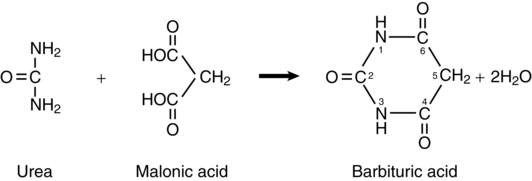Thiopental is no longer available in the United States because the governments of countries in which it is manufactured refuse to allow it to be exported to countries in which it is used for lethal injection. However, anesthesia providers should be familiar with the use of thiopental because, (1) from a historical perspective, for decades it was the most widely used intravenous drug to induce anesthesia and (2) thiopental is a core medicine on the World Health Organization’s Essential Drugs List. Thiopental is still widely used outside the United States, and anesthesia providers who travel to practice outside the United States for whatever reason must remain familiar with its pharmacokinetics and pharmacodynamics.
Barbituric acid (2,4,6,-trioxyhexahydropyrimidine) (Figure 71-1) was first synthesized by Adolph von Bäyer (founder of what was to become the Bayer chemical company) in 1864. Although this molecule is the structural framework from which barbiturates are derived, it is devoid of anesthetic properties. Structural modification at the number 2 and 5 carbon atoms results in barbiturate drugs that have sedative-hypnotic properties. For example, addition of a benzene ring at the C5 position results in phenobarbital, a drug first used for its sedative properties in the early 1900s and still one of the most widely used drugs in the world to treat seizure disorders. With the lack of thiopental in the United States, intensive care physicians are using phenobarbital to induce barbiturate coma in patients with raised intracranial pressure unresponsive to other therapies. Replacement of the oxygen atom with a sulfur atom at the C2 position and adding a large aliphatic carbon group to the C5 atom transforms barbituric acid into thiopental. Clinically, sodium thiopental was first administered in 1934 by Ralph Waters at the University of Wisconsin, Madison, and by John Lundy at the Mayo Clinic in Rochester, MN.
Commercially available thiopental [5-ethyl-5-(1-methyl-butyl)-2-thiobarbituric acid] is a racemic mixture of stereoisomers [the S(−) isomer is twice as potent as the R(+) counterpart] that is water soluble and highly alkaline (pKa of 7.6 and pH of 10.5). Decreased pH (e.g., mixing with opioids, catecholamines, or neuromuscular blocking agents) may result in precipitation. Reconstitution with Ringer’s lactate solution is not recommended. Refrigerated thiopental is stable for approximately 1 week following reconstitution with sterile water. Both isomers exert their biologic activity by enhancing and mimicking the action of γ-aminobutyric acid (GABA) at GABAA receptors.
Related
Fausts Anesthesiology Review Expert Consult 4e






